Inside the World’s Fastest 40-yard Dash
Contents
World’s Fastest 40-yard Dash Intro
The quest for the name of the quickest 40-backyard sprint is a constant pursuit that captures the creativeness and aggressive spirit of athletes worldwide. This quick dash, equating to 36.576 meters, is extra than only a check of pace; it`s a degree of an athlete’s explosive electricity, acceleration, and method. Over the years, statistics had been shattered and new legends had been born as generation, education methods, and our know-how of human overall performance evolve. But what does it take to gain the quickest 40-backyard sprint? This weblog publish dives deep into the sector of pace, exploring the present day document, the technology in the back of sprinting, how athletes educate for max velocity, the effect of generation on overall performance, and what the destiny holds for this electrifying event.
Breaking Down the Record
The document for the quickest 40-backyard sprint is presently held with the aid of using John Ross, who carried out an awe-inspiring time of 4.22 seconds on the 2017 NFL Combine. This wonderful feat shattered the preceding document, putting a brand new gold widespread in pace and showcasing the top of human athletic overall performance in quick-distance sprints. Ross’s accomplishment isn’t always only a mirrored image of his innate pace however a end result of rigorous education, most appropriate bodily conditioning, and a deep know-how of sprinting dynamics. It illustrates the remarkable consequences that may be carried out while expertise is matched with willpower and current training strategies. breaking dash has turn out to be a focus for athletes aspiring to go away their mark on the sector of sports, symbolizing the remaining undertaking in pace and agility. It highlights the acute opposition and the ever-evolving nature of athletic benchmarks, pushing athletes to discover the bounds in their capabilities. John Ross’s extraordinary sprint serves as a effective motivator, igniting the ambition of upcoming sprinters to task past hooked up limitations and redefine the requirements of pace.
The Science of Speed
At the coronary heart of the quickest 40-backyard sprint lies a captivating interaction of biomechanics and physics. The technology in the back of sprinting pace facilities round 3 crucial components: stride period, stride frequency, and floor response pressure. Elite athletes like John Ross gain wonderful instances with the aid of using maximizing their stride period and frequency with out sacrificing efficiency. This stability calls for now no longer best a excessive diploma of energy and electricity however additionally an most appropriate method that minimizes air resistance and maximizes ahead momentum.
Muscle fiber kind appreciably affects an athlete’s capacity to dash rapidly. Sprinters predominantly own a better share of kind II, or fast-twitch, muscle fibers, that are able to producing more pressure at a quicker price as compared to slow-twitch fibers. This muscle composition permits explosive begins offevolved and effective accelerations, that are essential withinside the 40-backyard sprint.
Neuromuscular coordination is any other cornerstone of sprinting science. The capacity to synchronize muscle contractions with unique timing complements the effectiveness of every stride. This coordination is evolved via repetitive exercise and focused education, permitting athletes to refine their approach to obtain height performance.
Additionally, the utility of pressure in opposition to the floor performs a pivotal position in propelling the sprinter ahead. The idea of `pressure utility’ underlines the significance of now no longer simply the quantity of pressure generated, however additionally the course and the rate at which it’s far applied. Efficient sprinters grasp the approach of making use of pressure in a way that optimizes their horizontal velocity, thereby lowering the time it takes to cowl the 40-backyard distance.
Understanding and making use of those clinical ideas allows athletes to push the limits of speed, putting the degree for record-breaking performances withinside the 40-backyard sprint.
Training for Speed
Preparing for the top of the 40-backyard sprint calls for an athlete to interact in a complete and specialised education regimen. Central to this practise is a balanced blend of physical activities geared toward bolstering explosive energy and improving speed. Plyometric education, which incorporates jumps and bounds, is essential because it develops the fast-twitch muscle fibers critical for brief begins offevolved and surprising bursts of speed. Olympic weightlifting movements, which include the smooth and jerk and the snatch, in addition make contributions to the improvement of explosive power vital for effective acceleration.
Sprint approach refinement is any other critical component. Athletes spend limitless hours operating on their beginning stance and primary steps, as a advanced begin can considerably effect the general dash time. Drills that emphasize right foot placement, frame alignment, and green use of electricity are routine. These drills are designed to ideal the sprinter`s form, making sure each movement contributes to most ahead momentum.
Flexibility and mobility physical activities can’t be overlooked, as they play a vast position in stopping accidents and improving muscle healing. Through dynamic stretches and focused mobility work, athletes make certain their our bodies can face up to the pains of extreme education at the same time as keeping the variety of movement wanted for most suitable sprinting approach.
Nutrition and healing techniques are similarly critical. A food regimen wealthy in vitamins helps muscle restore and growth, at the same time as ok relaxation and healing modalities like ice baths, massage, and compression remedy resource in lowering fatigue and improving muscle recuperation. This holistic technique to education, integrating power and energy improvement with approach refinement, flexibility, and healing, equips athletes with the gear they want to chase the name of the quickest 40-backyard sprint.
The Role of Technology
In the area of the quickest 40-backyard sprint, technological improvements had been game-changers, permitting athletes to fine-track their overall performance with extraordinary precision. The introduction of high-velocity video evaluation has been in particular transformative, taking into consideration the dissection of each section of the sprint. By breaking down the problematic information of an athlete`s movement, coaches and sports activities scientists can pick out minute inefficiencies in technique, from the preliminary go off the road to the very last stride throughout the finish. This stage of evaluation changed into as soon as unimaginable, supplying insights that cause marginal profits formerly overlooked.
Wearable generation has additionally made big strides, equipping athletes with the equipment to reveal numerous physiological metrics in real-time. Devices that song coronary heart rate, muscle activation, or even strain degrees empower athletes to optimize their schooling load and recuperation, making sure they may be constantly acting at the height in their abilities. This customized records series allows a extra tailor-made technique to schooling, wherein changes may be made at the fly primarily based totally on concrete records in place of guesswork.
Moreover, the innovation would not forestall at evaluation and wearables. The substances and layout of sprinting tools, which includes the evolution of spikes and the surfaces athletes compete on, have visible improvements geared toward decreasing resistance and growing performance. The improvement of lighter, extra aerodynamic footwear, coupled with tracks engineered to go back electricity to the sprinter, contributes to shaving vital milliseconds off a runner’s time.
In this landscape, generation serves now no longer simply as a device for enhancement however as a essential associate withinside the pursuit of velocity. By integrating those technological improvements into their schooling regimes, athletes aren’t simply chasing the contemporary file however reimagining the boundaries of the quickest 40-backyard sprint.
The Future of the 40-backyard Dash
Looking ahead, the search for reaching the quickest 40-backyard sprint is poised for groundbreaking evolutions. Innovations in biomechanics, state-of-the-art schooling approaches, or even the genetic make-up of athletes are at the verge of reworking conventional sprinting paradigms. Future sprinters will probable gain from hyper-customized schooling packages knowledgeable through genetic insights, taking into consideration optimizations in schooling, nutrition, and recuperation tailor-made to the individual’s specific physiological profile.
Emerging technology including AI-pushed analytics and digital fact simulations will provide athletes and coaches unprecedented insights into overall performance enhancement, developing simulations that may are expecting outcomes, refine techniques, or even visualize aggressive situations in extraordinary detail. These equipment will now no longer best beautify bodily education however additionally mental readiness, permitting sprinters to mentally rehearse their races, reading and overcoming capability demanding situations in a digital environment.
Moreover, the combination of next-technology substances in tools and footwear, designed to beautify biomechanical performance and decrease electricity loss, will offer any other layer of advantage. We can expect the improvement of smarter tracks and going for walks surfaces engineered to expand velocity and decrease harm risks, propelling athletes to new records.
As the arena stands at the cusp of those advancements, the narrative of the 40-backyard sprint will hold to evolve. New champions will emerge, information will fall, and the boundaries of human pace could be redefined. The pursuit of the quickest 40-backyard sprint is a testomony to human ambition and ingenuity, a story so that it will hold to captivate and encourage for generations to come.




